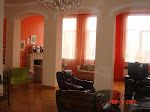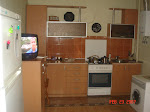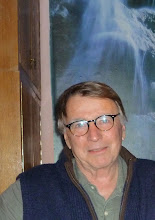Baku (or Baki in Georgian)
This is to go with the quicktime movie. From the cafeteria at the Tbilisi airport to Farida’s parents house (Rasim Aghammadova, me. Farida, Farida;s husband Akhmed, Farida’s mother Gizbike, Farida’s sister Fatima) and in the next picture Farida’s brother Orhan. The Tbilisi airport has free wifi.
The view of the market from Farida’s kitchen window and of a couple of industrious meat cutters butchering a steer which they dispatched nicely in less than an hour. Farida and Akhmed live on one of the highest hills in Baku in a neighborhood.
Then on to the museum of modern art, a beautiful building full of contemporary Azeri art—almost all of it modern and abstract in style. Downtown Baku is very modern.
If you note among the yellow photos of the works of art, there is one with the red devil like figures dancing on the tops of the buildings in Baku. The artist is intentionally critical of the huge modernization that is going on, a massive building project that transforms old Baku into a modern city full of European boutiques and very expensive chain stores from Italy and France and huge government buildings.
The pictures of the woman with the big shoulders and tiny waist is that of the president’s wife, a benefactor of this museum. (president is Ilham Aliyev) She is a very prominent Azerbaijani citizen.
On to the waterfront that reminded me a bit of Chicago although Chicago doesn’t have the hills toward the inland view. The Caspian Sea is a remarkable body of water. Wikepedia has some interesting facts about it. People told me about the sometime dramatic rise and fall of the water level. One night I was taken to a fish place in an old part of the city right by the Caspian. It was a cold, windy night with waves washing on the shore. There we ate kutum. This we ate broiled whole, we had to careful to pick the many bones out of the fish before we ate it.
The memorial to the resisters of the Soviet army’s attack on Baku’s new independence movement in 1990 sits high on a hill overlooking the city and waterfront. 137 people were killed and each one is memorialized at this place. It is quite moving. An eternal flame burns at the end of this long walkway. And 1990 was not that long ago.
There is a lot of construction everywhere. Here Farida and one of her friends leads us through a street under construction in search of a bite to eat which we eventually found at a wonderful airy cafe overlooking the park and old city.
More eating. A large carpet that Farida owns. And, the Azeri airlines plane that took me back to Tbilisi. Note it is a prop plane. Imagine how it rolled and plunged in the high winds ( 40-50 mph) encountered. It was interesting that this plane was less than half full on the trip to Baku and on the return had about ten people in it. It felt somewhat like I imagine a trip to the remote places of the globe might be like with few travelers adrift.








Nice writing about Baku and the wonderful hospitality by Farida :) Very enteresting I enjoyed reading the whole blog.
ReplyDeleteMasood
Thank you, Masood. I have not returned to this blog much but am going over it this spring (2013) as I try to figure out how to archive the blog itself and whether or not I want to write more about the experience as a Fulbrighter.
ReplyDelete